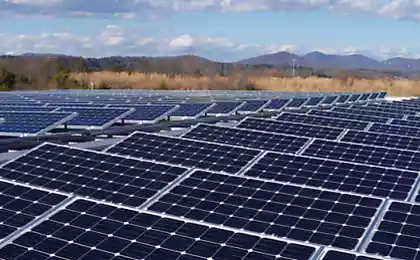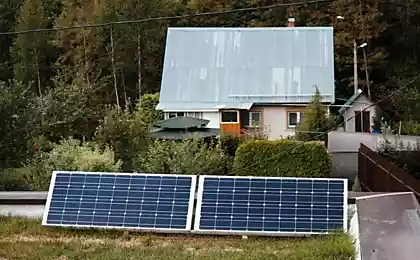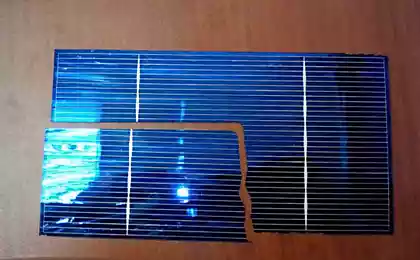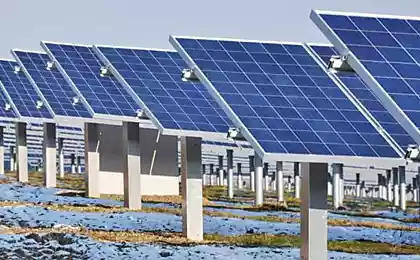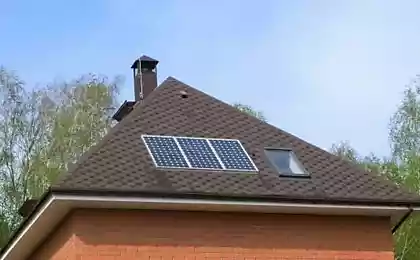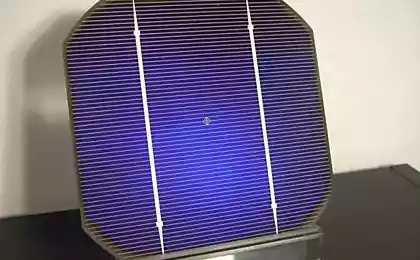770
The current status of solar energy in the conditions of U.S. households
Just don't panic, but by 2050 we will need to generate 15 TWh of renewable energy (not increasing carbon dioxide emissions) sources in order to stabilize the concentration of CO2 in the atmosphere. And in terms of availability, the greatest potential for this today is solar energy.
Solar energy is "probably the only solution for obtaining energy, as a fairly serious recoil, and quite acceptable for long-term [environmental] requirements of the planet," says Richard Perez, chief researcher, Research center for atmospheric Sciences at the state University of new York at Albany. The analysis of Peres ' includes geothermal, wind, other renewable sources, nuclear fusion and all kinds of fossil fuels.
So if wind, hydropower and geothermal sources in some regions are operating on a local scale, today's solar energy potential is superior to any other source of renewable energy is several orders of magnitude. This is the only candidate, besides nuclear energy, for a global solution for the extraction of huge amounts of energy.
On average, the Earth gets about 175 W/m2 of solar energy. If we assume that 10% of this energy can be converted into electricity, the supply of the necessary U.S. energy would require covering 2% of the earth US solar panels is roughly the area of North Dakota. Because it is 30 times more space on our roofs for the collection of the amount of energy required to build a large solar power plant.
But this does not diminish the usefulness of multiple panels on your roof. If you own your home, you can generate electricity yourself. You can reduce or eliminate your dependence on the electricity provider – and can even sell him the surplus, further reducing the cost or even making a profit.
The recent change of leadership of the state hints at the uncertainty of the solar initiatives in the United States. But some organizations, enterprises and citizens can decide for themselves whether to extend to them the use of solar energy. In order to better visualize the current state of the home use of solar energy in the U.S., we learned about the practice, economic aspects and the experiences of different people who have turned recently to their homes in a small power plant. I hope that even if you live in an apartment in the basement, this information will enlighten you....
Better than everIn childhood, we admired the calculators and clock running from the sun. Someone received as a gift the scientific sets, where tiny motors have been combined with solar panels the size of a palm. Creating electricity from light appeared to be magic. Why can't we do it in the world?
One of the main historical obstacles to civilization, living on solar energy – low efficiency and high cost of solar panels (SP) plate that converts photons into electricity. Their effectiveness, or rather, the photovoltaic conversion ratio is the ratio of electrical energy produced by the panels to the sunlight falling on its surface.

One of the first SP
Their story is quite long. The first SP was invented in 1883 by Charles Fritts dreamed, as his SP will compete with a growing network of coal-fired power plants Thomas Edison. But 1% of the efficiency of his SP made the dream impossible.
By 1954, bell labs demonstrated the public SP by connecting it to a toy Ferris wheel and a radio transmitter. The device had an efficiency of 6% which was a significant achievement compared with the previous SP. Also it really was already a panel on which several solar cells were connected in a solar battery. Although it was still too expensive for wide distribution, The New York Times was impressed with the demonstration and declared it "the beginning of a new era, which will lead to the realization of one of the most precious hopes of mankind – the exploration of the almost limitless energy of the Sun for the needs of civilization."
In the 50's and 60's, research continued silicon SP. Small SP started showing up in toys and consumer devices. By mid-decade, efficiency has doubled, but the price was too high, especially compared to the small cost of electricity of that time. Watt SP was worth $300, and the cost of 1 watt of energy obtained from power stations was 50 cents.
But by the end of the decade, SP has proved its utility as a source of energy for a fleet of artificial satellites. The US Navy initially skeptical about SP, they changed their minds when the regular battery first companion died a few days later. And SP maintained its performance over the years.
The cost of high SP used in satellites and space equipment, though high, but is only a small fraction of the total cost of these systems, and the relatively low cost of fuel and ground energy in 50-ies and 60-ies are not stimulated to reduce their cost. But by the early 70s was developed by the joint venture using the materials cheaper, and the cost of panels fell to $20 per watt. Together with the energy crisis of 1973 that triggered a new wave of interest in solar energy in terms of its land use.
But the technology was still not ready for the mass market: the efficiency was around 10%, and the cost remained high.
Today, there is increasing interest in solar energy both at home level and at larger scale. This is due to the addition of several factors: reduced cost; increasing the efficiency of the SP; a stimulating environment with regulators and taxes; spreading concern about climate change; entrepreneurial innovation.
A surge of interest linked with the exponential growth in the use of solar energy over the last 20 years. Prospects for growth remain. No less than 30 countries, including partially and the United States, with SP on the roof is cheaper than from the network – and that's not counting subsidies to purchase them.
What else helped the occurrence of SP in life, so it is a market with many alternatives to conventional panels placed on the roofs. Some companies sell aesthetically more attractive options, such as SP as a coating for roofs (the result is a brilliant roof, not protruding from it panel). One firm offers small home, designed for different customers, including a segment of consumers who try to minimize their contribution to greenhouse gas emissions. Some of these products come with integrated solar roofs and the ability to work fully Autonomous.
Elon Musk recently said that his "sun roof" in the installation will be cheaper than usual, not even counting its ability to generate electricity. Such an option would choose solar roof risk-free during construction.
Also, homeowners are not limited to the surface of the roof. The same technology is applicable to awnings for cars and other private buildings, and SP panels can be installed even in the field or in the yard.
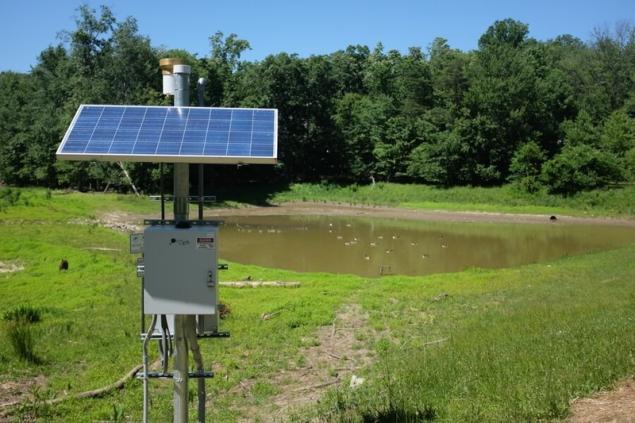
Autonomous station that monitors the state of water
Although we focus on solar energy in households growing segment of SP-structures of medium size. They are more than Pets, but less than large-scale solar power plants. On a recent trip to Maryland and Virginia, we noticed several plots of land planted with rows of SP, not corn, or pasture for cows. Small solar power plants are becoming a popular way of getting the advantage of solar energy for small communities without the need for every member of the community to buy their own system.
View SP, interspersed with grain crops, have reminded us that it's just the new way of operating an abundant and free energy of the Sun converting it into electricity, not into sugar through photosynthesis.
Dollars and kilowatt hoursso you've decided to collect solar energy. Whether it is a reasonable investment?
For many people it is not just revenues and expenses: the realization that you reduce your contribution to greenhouse gas emissions may outweigh pure financial considerations. And those who invest in a standalone system with battery power gets satisfaction from security and independence from local infrastructure.
But the system is worth the money. If you have not made a bargain with the installer, for most people the installation of SP on the roof is a serious investment. These costs are reduced by reducing your electricity bills, and possibly selling your energy back to the grid.
In addition to such General statements, it is impossible to make specific predictions about the cost of home solar energy. All because all the relevant factors very much depend on where you live. In cities where the cost of electricity is the highest investment in solar panels on the roof could compete with investment in index Fund. Where the cost of electricity is lower and weather conditions, SP is inefficient, it may be a waste of money (not counting the above-mentioned other reasons). The cost of selling electricity back to the grid also depends on regions.
Researcher energy Joshua Rhodes notes that the average cost of a solar energy JV on the roof, given the setting, time of life and other factors, the US is now on par with the cost of energy from the network: approximately 12 cents per kWh. It could be the turning point, meaning that every homeowner, real or potential, should be seriously considered by SP as part of its investment.
But these figures hide the details. The cost obtained from the energy network in the country can vary 10-fold, and the cost of installing the panels and sunlight also vary greatly. Rhodes gathered her data on the maps showing where home solar power is worth the investment, and where it is not yet ready for implementation.
The result are large regions where great as the cost of energy and the amount of sunlight, like southern California – where the installation of panels might be a good idea. In Washington state bad with the sun and cheap electricity, so there might not be sense.
But this information quickly becomes outdated. Conventional silicon SP, constantly falling in price, mainly due to economies of scale. This process may be close to saturation of the market, and the future cost reduction may be based on the research of new types of solar cells or production methods.
A real example ofNick white lives in Denver, Colorado, he has installed SP my roof just over a year ago and kept detailed records. He shared them with us, and their study will be informative.
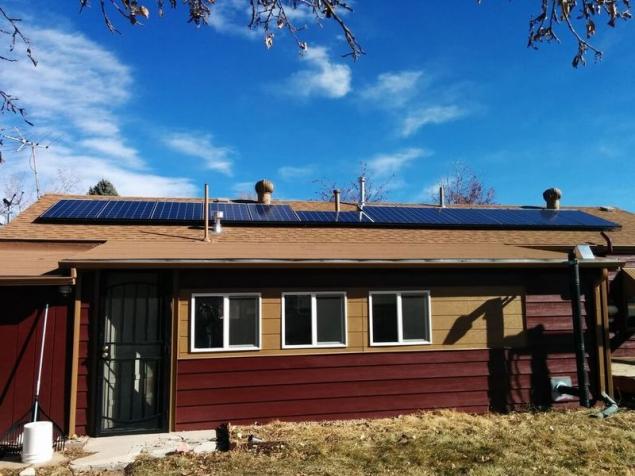
Nick tracked his way out of the solar system and found that the joint venture generated approximately 3400 kWh of electricity in its first year of operation. During this period, its economy consumed approximately 4200 kWh, 800 kWh more than made the Sun. The surplus came from the mains.
Electricity from the network costs 13 cents per kWh, so the bill for 800 kWh would have been $104. But according to the rules of the energy company needs to pay white for 3 cents for every kWh produced by its panels. The subsidy is intended to reduce the cost of installing SP. In other States there are similar subsidies.
Total fee per panel made up 3400 * 3 TS, that is $102. As a result, the expense of the white $2. No panels would have 4200 kWh * 13 C, or $546, so the Sun brought a profit of $546 — $2 = $544 for the year.
White notes that the refund of $544 divided by the installation cost of $7672 (after tax), gives him a %7.09 return (not counting interest on the loan for the installation). White believes that properly invested. And because over the years the cost of electricity from the network increases, savings will increase, even with the slight degradation of efficiency of the panels.
About their work he says: "I do not think about them. They are always on and care for them is not necessary."
The energy consumption of the house white is modest (about half of the average in the region) because before installing the SP, he invested in efficient technologies. He estimates that the savings from using led lamps and efficient home appliances work even more than from the panels.
Perhaps more important than the financial aspect panels is the fact that the family of white a bit reduced greenhouse gas emissions: 60% energy Colorado receives from coal combustion. For him it is "the best of all results."
A white a lot of traveling in the motorhome, which they also supplied SP on the roof. This is a stand-alone system with batteries. They estimate that the Autonomous motorhome is worth 2-5 times more than usual.
Perhaps a useful example from overseasBefore thinking about installing SP onto the roof, you need to evaluate the available surface area and the amount of received sunlight. This will allow you to determine whether the system is to give enough energy in order for it to make sense. Local installers can carry out the calculations for you, but it is certainly profitable to sell you a panel. So all in all it's a good idea to independently estimate, what to expect from the system, before going to such a company.
Sunroof Project site from Google, which, having received your address, will combine information about your roof with the local weather, shading and try to calculate the economic aspect of SP on the roof of your home. It can be useful as a rough estimate or help in choosing between several options of homes that you want to buy, but the project is still at an early stage, and is not capable of detailed analysis. For example, he believes that the entire roof surface available for the installation of SP, although it is possible that local laws and practical considerations will not allow you to take it all. And at the time of this writing the site has no calculation for all possible locations.
Example of unconventional use of solar energy, which is unlikely to be able to calculate the algorithms from Google, will be the experience of Kris de Decker, host your blog "low tech Magazine" of belonging him apartment near Barcelona in Spain. Recently he decided to experiment and to power its office exclusively on solar panels. And while we're talking about the United States, his experience is interesting. The average solar energy in Barcelona in 1700 kWh/m2/year coincides with the United States.
De Decker has no access to the roof, so he used Windows. It turned out that they are perfectly open to a direction between the South and the South-East, and they are not shade trees or buildings. But small panels set it on the windowsill, not enough to power the office.
He was able to increase the results of SP, built for them in the holders so that the panels were tilted at an angle that gathers the most energy from the Sun (photo below). This is the strategy adopted for solar power plants, but it is usually unavailable for typical homes, where panels are simply mounted to the roof. De Decker had increased the average annual results by about 10%, periodically changing tilt angle of panels, so that this advantage actually turned out to be more than it seems. The increase in issuance was necessary in the winter, when it is very important to squeeze all the available watts from the system. In these months a tilted panel can give 3 times more energy than horizontal.

More important was the transformation of his office into a system that works from DC 12 V. Various SP give different DC voltage, 12V is the most common voltage for small panels. This is useful for powering many electronic devices, such as laptops, working from 12 V. When you turn on the laptop in AC power, the power pack transforms 120 V (US) AC to 12V DC, resulting in lost energy. This loss is easy to feel on the heating unit.
Below is a typical collection system of solar energy combined with electrical wiring, its DC current is fed through the inverter and the transformer, converts it into a current of 120 V and 60 Hz (in the USA), demand for home electronics. Instead of having to convert the output of the panels and to lose energy, de Decker has transformed devices so that they consume the current in the 12V directly from the panels. In most cases, it was enough to use a different power cord. The result was to preserve 40% of the energy that is strongly influenced by the success of his experiment.
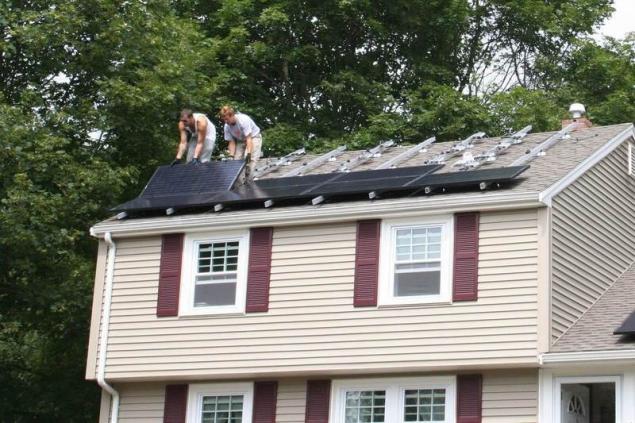
The installation of the SP in Massachusetts
Our last example was created by Benjamin Meyer, who lives in Massachusetts. The climate in New England is not ideal, and panels are often blocked with snow. However, in the course of a year they generate more energy than consumed in the household. Meyer in response to the set air conditioning and other devices to bring consumption in line with production. 5 years after installation paid for itself, given subsidies from the state and tax concessions.
"I rarely thought about the panels, said Meyer. The most difficult was to install them and enable for the first time, and see how the counter turns in the opposite direction, knowing that you do not pay for electricity. I think everyone who set panel, can tell you about this moment."
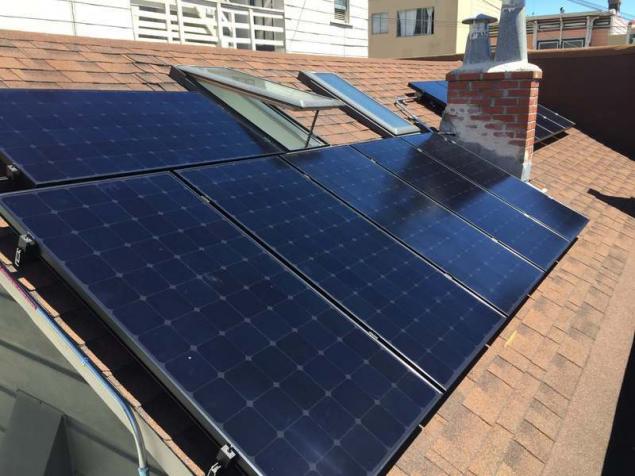
SP on the roof in California
At the other end of the country, in San Francisco, we were graciously agreed to advise Dan Birken, programmer. His SP on the roof provide energy for almost a year. He describes their spending on SP as "the best investment", but noted that "I bought them not for the sake of investing money, but because I wanted to I had my own panel because it is not the most terrible investment. Fun to get your own energy from the Sun."
Birkin, estimates that his system saves him from $900 to $1200 a year, including the cost of selling energy back to the grid.
The house of Birken fell under common law prohibiting the place SP is closer than 90 cm from the ridge of the roof. This is done so that the firemen could if anything to move on the roof, but the law reduces the useful area of the small roof. Popular online calculators usually do not take into account such subtleties.
Offer you can not refusethere is No doubt that kWh large scale solar power plants is cheaper than a small home. Generally, the cost of energy large solar power plants has recently become slightly lower than those of gas power plants.
One of the reasons for the attractiveness of the home SP – ability to get a good subsidy that reduces the cost of the system. In the US, now there are a few rules for making homemade SP attractive. Now there are 30% tax credit on installation of solar energy systems; it will run until 2019, and then decrease, and in 2021 will disappear. With some reservations it is also applicable for solar water-heating systems.
This discount is already considerably stimulated research in the field of SP and their home setting. Although it will soon disappear, was extended to the previous tax concessions. Congress will consider the tax break every year, so this may change. In addition to the Federal discounts as well as discounts on specific States.
Another type of stimulation of use of solar energy has recently entered into force in San Francisco. As the perfect example of proposal you cannot refuse, the city commits to equip all new buildings with any type of system of producing energy from the sun.
The fight against the darknessLet's make an obvious statement: the solar panels don't work at night or under snow. Usually, however, the electricity needed us around the clock. To do this we need to store the excess energy produced by solar days, and remove it when generation is unavailable.
Large solar power plants, public and commercial use different ways to store energy, and can choose the best option, depending on the environment. They can store solar energy in the form of gravitational potential by pumping water into elevated reservoirs and then deriving the energy pouring water through the turbines. They can squeeze the tank with gas, or springs that use the chemical energy in the conventional batteries, or to use more complicated processes, like making water from hydrogen, which can then be burned.
The only practical solution for the home system from this list will be the electric battery. But at the current stage of development, the cost of purchase and maintenance of batteries is very high. As a result, the majority of people use connecting power and refuse autonomy. This allows you to sell excess energy into the grid by day and take electricity from the network at night or at any other time when the panels are not working.
Use the mains as the battery makes installation SP not only easier and cheaper but also allows the system to quickly pay off, because in many States, utilities are required to pay households for the energy that is transmitted to the network. However, during a local blackout when energy can be you need, your system will shut down for reasons of safety for employees of the company, which will repair the network.
The obvious choice for storing energy are batteries, and they are usually lead-acid batteries, like in cars. Recently Tesla Motors announced that adapted the technology of lithium-ion batteries used in its electric cars, for home use as a backup battery. Device PowerWall is designed to work how to collect solar energy and provide backup power in case of outages.
Improving the performance of the batteries and reducing their cost is just as important as improving the efficiency of solar panels. If recent progress continues, these systems will become more popular. If the market share of electric vehicles will increase, such batteries can become the predominant method of energy storage and leveling demand – after all, who would buy an electric car, will put their money into the battery.
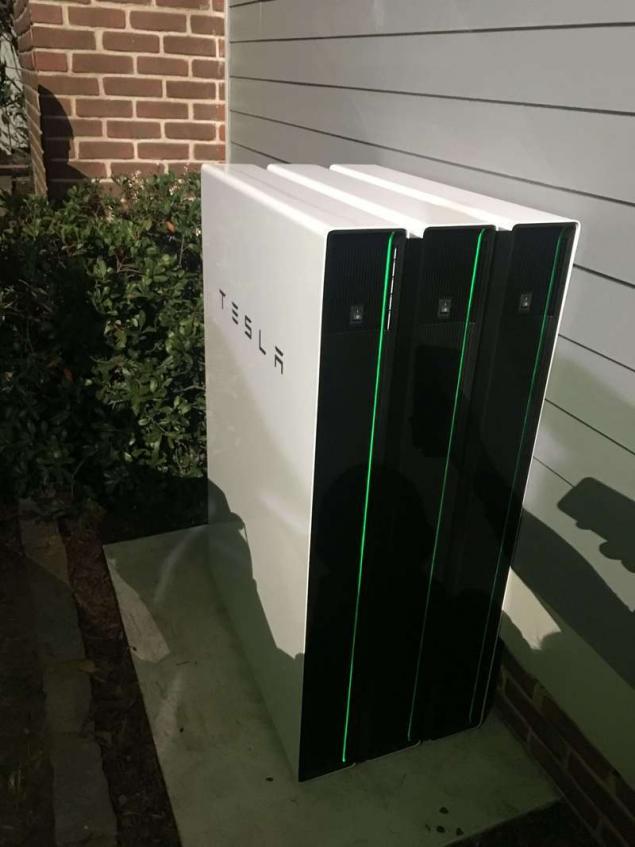
PowerWall2
Recent purchase of a Tesla is the company SolarCity is part of the strategy (in financial circles consider with great scepticism) the creation of vertically integrated company, supplying solar energy systems for its storage and vehicles, consuming her – despite the fact that these cars will potentially become part of the energy storage system. Analysts predict that by 2020, battery vehicles Tesla will keep 70 GW of energy – not counting the machines of other manufacturers.
Tesla already seriously invested in the project Tesla, in 2016, installed more batteries than all of the company established in 2015 in the United States. The company intends to produce "easy-to-integrate and beautiful system "solar roof with battery" that just works, gives energy to the consumer, and then scale it around the world." After the purchase, SolarCity Musk with announced plans and on technological developments that coincide with this purpose, including advanced inverters and solar roof.
Finish reading up to this point it is clear that the history of the home solar energy complex and subject to constant changes, thanks to the rapid progress in research and the constantly changing tax landscape. But technology and Economics have already reached such a state that we can be sure that SP on the roof definitely makes sense if you have your home in a Sunny region... unless, of course, local rules and laws are not erected too many obstacles.
For homes in less than comfortable climatic conditions is harder to prove the rationality of the unit SP. But you can still convince some independence from the local power company, as well as joining the ranks of citizens who responsibly suitable to the climate challenges facing our planet. published
P. S. And remember, only by changing their consumption — together we change the world! ©
Source: geektimes.ru/post/286054/
Solar energy is "probably the only solution for obtaining energy, as a fairly serious recoil, and quite acceptable for long-term [environmental] requirements of the planet," says Richard Perez, chief researcher, Research center for atmospheric Sciences at the state University of new York at Albany. The analysis of Peres ' includes geothermal, wind, other renewable sources, nuclear fusion and all kinds of fossil fuels.
So if wind, hydropower and geothermal sources in some regions are operating on a local scale, today's solar energy potential is superior to any other source of renewable energy is several orders of magnitude. This is the only candidate, besides nuclear energy, for a global solution for the extraction of huge amounts of energy.
On average, the Earth gets about 175 W/m2 of solar energy. If we assume that 10% of this energy can be converted into electricity, the supply of the necessary U.S. energy would require covering 2% of the earth US solar panels is roughly the area of North Dakota. Because it is 30 times more space on our roofs for the collection of the amount of energy required to build a large solar power plant.
But this does not diminish the usefulness of multiple panels on your roof. If you own your home, you can generate electricity yourself. You can reduce or eliminate your dependence on the electricity provider – and can even sell him the surplus, further reducing the cost or even making a profit.
The recent change of leadership of the state hints at the uncertainty of the solar initiatives in the United States. But some organizations, enterprises and citizens can decide for themselves whether to extend to them the use of solar energy. In order to better visualize the current state of the home use of solar energy in the U.S., we learned about the practice, economic aspects and the experiences of different people who have turned recently to their homes in a small power plant. I hope that even if you live in an apartment in the basement, this information will enlighten you....
Better than everIn childhood, we admired the calculators and clock running from the sun. Someone received as a gift the scientific sets, where tiny motors have been combined with solar panels the size of a palm. Creating electricity from light appeared to be magic. Why can't we do it in the world?
One of the main historical obstacles to civilization, living on solar energy – low efficiency and high cost of solar panels (SP) plate that converts photons into electricity. Their effectiveness, or rather, the photovoltaic conversion ratio is the ratio of electrical energy produced by the panels to the sunlight falling on its surface.

One of the first SP
Their story is quite long. The first SP was invented in 1883 by Charles Fritts dreamed, as his SP will compete with a growing network of coal-fired power plants Thomas Edison. But 1% of the efficiency of his SP made the dream impossible.
By 1954, bell labs demonstrated the public SP by connecting it to a toy Ferris wheel and a radio transmitter. The device had an efficiency of 6% which was a significant achievement compared with the previous SP. Also it really was already a panel on which several solar cells were connected in a solar battery. Although it was still too expensive for wide distribution, The New York Times was impressed with the demonstration and declared it "the beginning of a new era, which will lead to the realization of one of the most precious hopes of mankind – the exploration of the almost limitless energy of the Sun for the needs of civilization."
In the 50's and 60's, research continued silicon SP. Small SP started showing up in toys and consumer devices. By mid-decade, efficiency has doubled, but the price was too high, especially compared to the small cost of electricity of that time. Watt SP was worth $300, and the cost of 1 watt of energy obtained from power stations was 50 cents.
But by the end of the decade, SP has proved its utility as a source of energy for a fleet of artificial satellites. The US Navy initially skeptical about SP, they changed their minds when the regular battery first companion died a few days later. And SP maintained its performance over the years.
The cost of high SP used in satellites and space equipment, though high, but is only a small fraction of the total cost of these systems, and the relatively low cost of fuel and ground energy in 50-ies and 60-ies are not stimulated to reduce their cost. But by the early 70s was developed by the joint venture using the materials cheaper, and the cost of panels fell to $20 per watt. Together with the energy crisis of 1973 that triggered a new wave of interest in solar energy in terms of its land use.
But the technology was still not ready for the mass market: the efficiency was around 10%, and the cost remained high.
Today, there is increasing interest in solar energy both at home level and at larger scale. This is due to the addition of several factors: reduced cost; increasing the efficiency of the SP; a stimulating environment with regulators and taxes; spreading concern about climate change; entrepreneurial innovation.
A surge of interest linked with the exponential growth in the use of solar energy over the last 20 years. Prospects for growth remain. No less than 30 countries, including partially and the United States, with SP on the roof is cheaper than from the network – and that's not counting subsidies to purchase them.
What else helped the occurrence of SP in life, so it is a market with many alternatives to conventional panels placed on the roofs. Some companies sell aesthetically more attractive options, such as SP as a coating for roofs (the result is a brilliant roof, not protruding from it panel). One firm offers small home, designed for different customers, including a segment of consumers who try to minimize their contribution to greenhouse gas emissions. Some of these products come with integrated solar roofs and the ability to work fully Autonomous.
Elon Musk recently said that his "sun roof" in the installation will be cheaper than usual, not even counting its ability to generate electricity. Such an option would choose solar roof risk-free during construction.
Also, homeowners are not limited to the surface of the roof. The same technology is applicable to awnings for cars and other private buildings, and SP panels can be installed even in the field or in the yard.

Autonomous station that monitors the state of water
Although we focus on solar energy in households growing segment of SP-structures of medium size. They are more than Pets, but less than large-scale solar power plants. On a recent trip to Maryland and Virginia, we noticed several plots of land planted with rows of SP, not corn, or pasture for cows. Small solar power plants are becoming a popular way of getting the advantage of solar energy for small communities without the need for every member of the community to buy their own system.
View SP, interspersed with grain crops, have reminded us that it's just the new way of operating an abundant and free energy of the Sun converting it into electricity, not into sugar through photosynthesis.
Dollars and kilowatt hoursso you've decided to collect solar energy. Whether it is a reasonable investment?
For many people it is not just revenues and expenses: the realization that you reduce your contribution to greenhouse gas emissions may outweigh pure financial considerations. And those who invest in a standalone system with battery power gets satisfaction from security and independence from local infrastructure.
But the system is worth the money. If you have not made a bargain with the installer, for most people the installation of SP on the roof is a serious investment. These costs are reduced by reducing your electricity bills, and possibly selling your energy back to the grid.
In addition to such General statements, it is impossible to make specific predictions about the cost of home solar energy. All because all the relevant factors very much depend on where you live. In cities where the cost of electricity is the highest investment in solar panels on the roof could compete with investment in index Fund. Where the cost of electricity is lower and weather conditions, SP is inefficient, it may be a waste of money (not counting the above-mentioned other reasons). The cost of selling electricity back to the grid also depends on regions.
Researcher energy Joshua Rhodes notes that the average cost of a solar energy JV on the roof, given the setting, time of life and other factors, the US is now on par with the cost of energy from the network: approximately 12 cents per kWh. It could be the turning point, meaning that every homeowner, real or potential, should be seriously considered by SP as part of its investment.
But these figures hide the details. The cost obtained from the energy network in the country can vary 10-fold, and the cost of installing the panels and sunlight also vary greatly. Rhodes gathered her data on the maps showing where home solar power is worth the investment, and where it is not yet ready for implementation.
The result are large regions where great as the cost of energy and the amount of sunlight, like southern California – where the installation of panels might be a good idea. In Washington state bad with the sun and cheap electricity, so there might not be sense.
But this information quickly becomes outdated. Conventional silicon SP, constantly falling in price, mainly due to economies of scale. This process may be close to saturation of the market, and the future cost reduction may be based on the research of new types of solar cells or production methods.
A real example ofNick white lives in Denver, Colorado, he has installed SP my roof just over a year ago and kept detailed records. He shared them with us, and their study will be informative.

Nick tracked his way out of the solar system and found that the joint venture generated approximately 3400 kWh of electricity in its first year of operation. During this period, its economy consumed approximately 4200 kWh, 800 kWh more than made the Sun. The surplus came from the mains.
Electricity from the network costs 13 cents per kWh, so the bill for 800 kWh would have been $104. But according to the rules of the energy company needs to pay white for 3 cents for every kWh produced by its panels. The subsidy is intended to reduce the cost of installing SP. In other States there are similar subsidies.
Total fee per panel made up 3400 * 3 TS, that is $102. As a result, the expense of the white $2. No panels would have 4200 kWh * 13 C, or $546, so the Sun brought a profit of $546 — $2 = $544 for the year.
White notes that the refund of $544 divided by the installation cost of $7672 (after tax), gives him a %7.09 return (not counting interest on the loan for the installation). White believes that properly invested. And because over the years the cost of electricity from the network increases, savings will increase, even with the slight degradation of efficiency of the panels.
About their work he says: "I do not think about them. They are always on and care for them is not necessary."
The energy consumption of the house white is modest (about half of the average in the region) because before installing the SP, he invested in efficient technologies. He estimates that the savings from using led lamps and efficient home appliances work even more than from the panels.
Perhaps more important than the financial aspect panels is the fact that the family of white a bit reduced greenhouse gas emissions: 60% energy Colorado receives from coal combustion. For him it is "the best of all results."
A white a lot of traveling in the motorhome, which they also supplied SP on the roof. This is a stand-alone system with batteries. They estimate that the Autonomous motorhome is worth 2-5 times more than usual.
Perhaps a useful example from overseasBefore thinking about installing SP onto the roof, you need to evaluate the available surface area and the amount of received sunlight. This will allow you to determine whether the system is to give enough energy in order for it to make sense. Local installers can carry out the calculations for you, but it is certainly profitable to sell you a panel. So all in all it's a good idea to independently estimate, what to expect from the system, before going to such a company.
Sunroof Project site from Google, which, having received your address, will combine information about your roof with the local weather, shading and try to calculate the economic aspect of SP on the roof of your home. It can be useful as a rough estimate or help in choosing between several options of homes that you want to buy, but the project is still at an early stage, and is not capable of detailed analysis. For example, he believes that the entire roof surface available for the installation of SP, although it is possible that local laws and practical considerations will not allow you to take it all. And at the time of this writing the site has no calculation for all possible locations.
Example of unconventional use of solar energy, which is unlikely to be able to calculate the algorithms from Google, will be the experience of Kris de Decker, host your blog "low tech Magazine" of belonging him apartment near Barcelona in Spain. Recently he decided to experiment and to power its office exclusively on solar panels. And while we're talking about the United States, his experience is interesting. The average solar energy in Barcelona in 1700 kWh/m2/year coincides with the United States.
De Decker has no access to the roof, so he used Windows. It turned out that they are perfectly open to a direction between the South and the South-East, and they are not shade trees or buildings. But small panels set it on the windowsill, not enough to power the office.
He was able to increase the results of SP, built for them in the holders so that the panels were tilted at an angle that gathers the most energy from the Sun (photo below). This is the strategy adopted for solar power plants, but it is usually unavailable for typical homes, where panels are simply mounted to the roof. De Decker had increased the average annual results by about 10%, periodically changing tilt angle of panels, so that this advantage actually turned out to be more than it seems. The increase in issuance was necessary in the winter, when it is very important to squeeze all the available watts from the system. In these months a tilted panel can give 3 times more energy than horizontal.

More important was the transformation of his office into a system that works from DC 12 V. Various SP give different DC voltage, 12V is the most common voltage for small panels. This is useful for powering many electronic devices, such as laptops, working from 12 V. When you turn on the laptop in AC power, the power pack transforms 120 V (US) AC to 12V DC, resulting in lost energy. This loss is easy to feel on the heating unit.
Below is a typical collection system of solar energy combined with electrical wiring, its DC current is fed through the inverter and the transformer, converts it into a current of 120 V and 60 Hz (in the USA), demand for home electronics. Instead of having to convert the output of the panels and to lose energy, de Decker has transformed devices so that they consume the current in the 12V directly from the panels. In most cases, it was enough to use a different power cord. The result was to preserve 40% of the energy that is strongly influenced by the success of his experiment.

The installation of the SP in Massachusetts
Our last example was created by Benjamin Meyer, who lives in Massachusetts. The climate in New England is not ideal, and panels are often blocked with snow. However, in the course of a year they generate more energy than consumed in the household. Meyer in response to the set air conditioning and other devices to bring consumption in line with production. 5 years after installation paid for itself, given subsidies from the state and tax concessions.
"I rarely thought about the panels, said Meyer. The most difficult was to install them and enable for the first time, and see how the counter turns in the opposite direction, knowing that you do not pay for electricity. I think everyone who set panel, can tell you about this moment."

SP on the roof in California
At the other end of the country, in San Francisco, we were graciously agreed to advise Dan Birken, programmer. His SP on the roof provide energy for almost a year. He describes their spending on SP as "the best investment", but noted that "I bought them not for the sake of investing money, but because I wanted to I had my own panel because it is not the most terrible investment. Fun to get your own energy from the Sun."
Birkin, estimates that his system saves him from $900 to $1200 a year, including the cost of selling energy back to the grid.
The house of Birken fell under common law prohibiting the place SP is closer than 90 cm from the ridge of the roof. This is done so that the firemen could if anything to move on the roof, but the law reduces the useful area of the small roof. Popular online calculators usually do not take into account such subtleties.
Offer you can not refusethere is No doubt that kWh large scale solar power plants is cheaper than a small home. Generally, the cost of energy large solar power plants has recently become slightly lower than those of gas power plants.
One of the reasons for the attractiveness of the home SP – ability to get a good subsidy that reduces the cost of the system. In the US, now there are a few rules for making homemade SP attractive. Now there are 30% tax credit on installation of solar energy systems; it will run until 2019, and then decrease, and in 2021 will disappear. With some reservations it is also applicable for solar water-heating systems.
This discount is already considerably stimulated research in the field of SP and their home setting. Although it will soon disappear, was extended to the previous tax concessions. Congress will consider the tax break every year, so this may change. In addition to the Federal discounts as well as discounts on specific States.
Another type of stimulation of use of solar energy has recently entered into force in San Francisco. As the perfect example of proposal you cannot refuse, the city commits to equip all new buildings with any type of system of producing energy from the sun.
The fight against the darknessLet's make an obvious statement: the solar panels don't work at night or under snow. Usually, however, the electricity needed us around the clock. To do this we need to store the excess energy produced by solar days, and remove it when generation is unavailable.
Large solar power plants, public and commercial use different ways to store energy, and can choose the best option, depending on the environment. They can store solar energy in the form of gravitational potential by pumping water into elevated reservoirs and then deriving the energy pouring water through the turbines. They can squeeze the tank with gas, or springs that use the chemical energy in the conventional batteries, or to use more complicated processes, like making water from hydrogen, which can then be burned.
The only practical solution for the home system from this list will be the electric battery. But at the current stage of development, the cost of purchase and maintenance of batteries is very high. As a result, the majority of people use connecting power and refuse autonomy. This allows you to sell excess energy into the grid by day and take electricity from the network at night or at any other time when the panels are not working.
Use the mains as the battery makes installation SP not only easier and cheaper but also allows the system to quickly pay off, because in many States, utilities are required to pay households for the energy that is transmitted to the network. However, during a local blackout when energy can be you need, your system will shut down for reasons of safety for employees of the company, which will repair the network.
The obvious choice for storing energy are batteries, and they are usually lead-acid batteries, like in cars. Recently Tesla Motors announced that adapted the technology of lithium-ion batteries used in its electric cars, for home use as a backup battery. Device PowerWall is designed to work how to collect solar energy and provide backup power in case of outages.
Improving the performance of the batteries and reducing their cost is just as important as improving the efficiency of solar panels. If recent progress continues, these systems will become more popular. If the market share of electric vehicles will increase, such batteries can become the predominant method of energy storage and leveling demand – after all, who would buy an electric car, will put their money into the battery.

PowerWall2
Recent purchase of a Tesla is the company SolarCity is part of the strategy (in financial circles consider with great scepticism) the creation of vertically integrated company, supplying solar energy systems for its storage and vehicles, consuming her – despite the fact that these cars will potentially become part of the energy storage system. Analysts predict that by 2020, battery vehicles Tesla will keep 70 GW of energy – not counting the machines of other manufacturers.
Tesla already seriously invested in the project Tesla, in 2016, installed more batteries than all of the company established in 2015 in the United States. The company intends to produce "easy-to-integrate and beautiful system "solar roof with battery" that just works, gives energy to the consumer, and then scale it around the world." After the purchase, SolarCity Musk with announced plans and on technological developments that coincide with this purpose, including advanced inverters and solar roof.
Finish reading up to this point it is clear that the history of the home solar energy complex and subject to constant changes, thanks to the rapid progress in research and the constantly changing tax landscape. But technology and Economics have already reached such a state that we can be sure that SP on the roof definitely makes sense if you have your home in a Sunny region... unless, of course, local rules and laws are not erected too many obstacles.
For homes in less than comfortable climatic conditions is harder to prove the rationality of the unit SP. But you can still convince some independence from the local power company, as well as joining the ranks of citizens who responsibly suitable to the climate challenges facing our planet. published
P. S. And remember, only by changing their consumption — together we change the world! ©
Source: geektimes.ru/post/286054/
The real disadvantages and risks during the construction of straw houses
How to make a swing gate operator with his own hands












